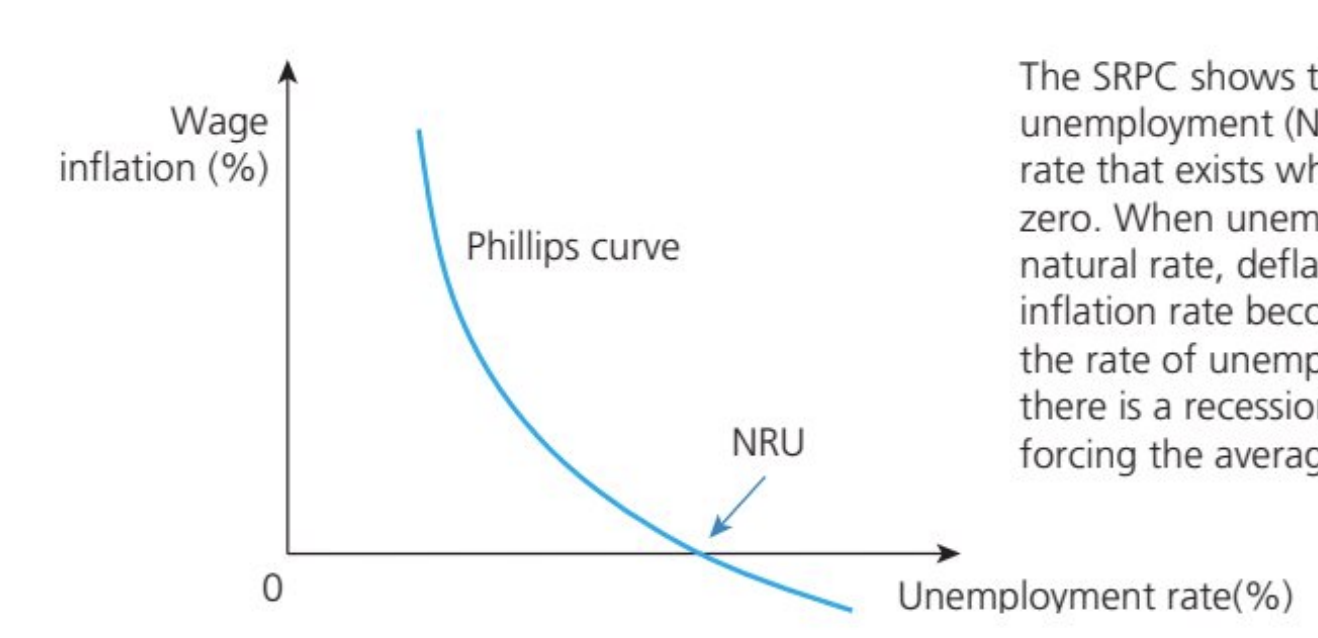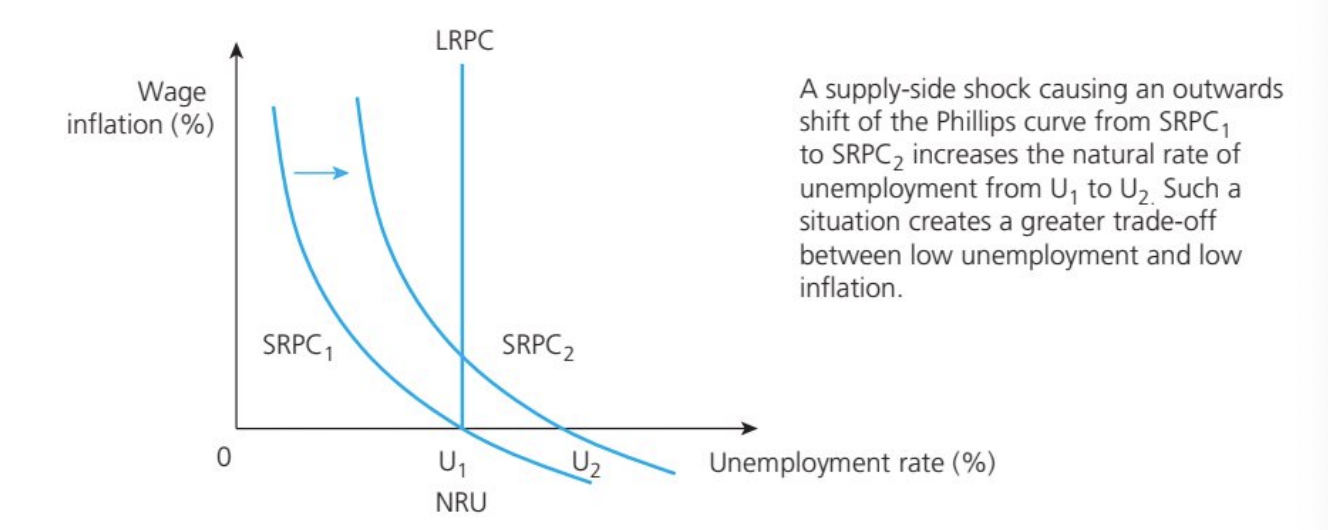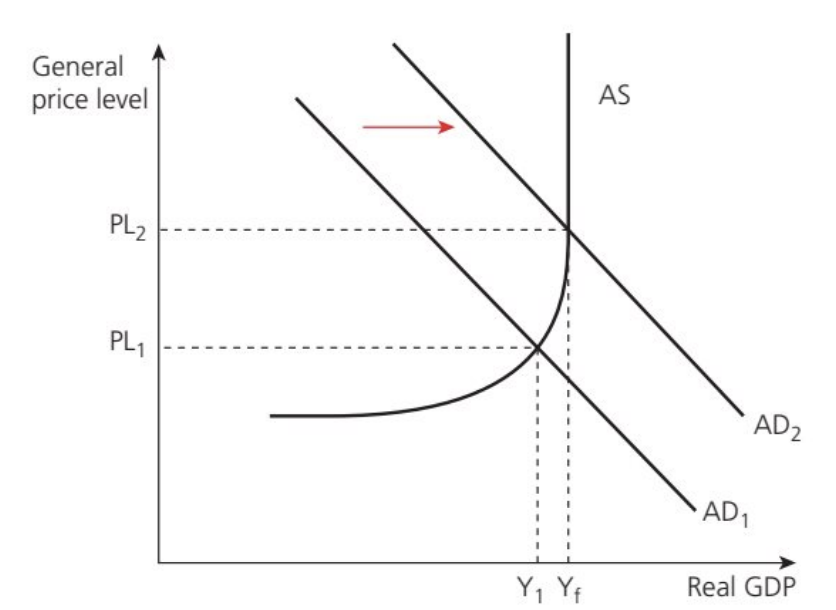Macroeconomic Objectives- Potential conflict between macroeconomic objectives
1/11
There's no tags or description
Looks like no tags are added yet.
Name | Mastery | Learn | Test | Matching | Spaced |
|---|
No study sessions yet.
12 Terms
Examples of potential conflict between macroeconomic objectives
low unemployment and low inflation
high economic growth and low inflation
high economic growth and environmental sustainability
high economic growth and equity in income distribution
Low unemployment and low inflation
When the economy grows rapidly, more people are in paid employment so inflationary pressures are likely to occur as the economy reaches its full employment level of national output
However, economic growth fuelled by higher AD is likely to result in demand-pull inflation as AD increases faster than AS
Alternatively, low unemployment can cause cost-push inflation because full employment makes it harder for firms to attract skilled labour. Hence, this can lead to wage inflation (and higher prices in general)

Trade-off between unemployment and inflation
Can be demonstrated by the Phillips curve, suggesting that the government might not be able to achieve both macroeconomic objectives at the same time.
Short run Phillips curve (SRPC)
shows a potential trade-off between pursuing low employment and low inflation as macroeconomic objectives.
A fall in unemployment, due to an increase in AD and economic growth, creates more consumption expenditure, thereby fueling higher average prices in the economy (shown by a movement up to the left along the SRPC). As the rate of unemployment falls, the rate of wage inflation increases, thereby creating a trade-off

What factors can shift the short run phillips curve?
Supply-side shocks, such as oil shortages causing price hikes, financial crises, natural disasters, and the widespread outbreak of infectious diseases

The long run phillips curve (LRPC)
shows that in the long run, there is a single rate of unemployment (the natural rate at U!), that is consistent with a stable inflation rate. HEnce, the LRPC is vertical, that is, there is no trade-of between low inflation and low unemployment
The LRPC model shows that any short-term attempts to reduce unemployment beyond its natural rate (NRU) will be ineffective and unsustainable in the long run as the resulting inflation leads to workers expecting and demanding higher nominal wages without any gain in employment levels
Most governments strive to reduce the NRU (shifting the LRPC to the left) by creating incentives to work and encouraging more (ret)raining schemes for the unemployed to improve their occupational mobility.

High economic growth and low inflation
Economic growth is usually associated with an increase in the level of AD in the country. It occurs when there is an increase in any of its components, that is, consumption, investment, government spending and exports.
However, as the economy continually grows, the risks associated with inflation become higher, especially as the economy approaches its full employment level of output
If AD rises faster than AS, demand-pull inflation occurs.
Cost-push inflation can also occur as high rates of economic growth make it more challenging for firms to attract suitably skilled labour, which can lead to wage inflation (and hence higher prices in general)

Why is controlled inflation not bad for the economy?
Inflation that is monitored and controlled makes conditions more predictable for consumers, producers and the government.
Hence, controlled inflation can be positive for economic growth.
It is only when inflation rises too quickly and is uncontrolled that it reduces the international competitiveness of the country, which can lead to negative economic growth and job losses
High economic growth and environmental sustainabiity
Economic growth is generally associated with negative impacts on the natural environment and sustainability.
As an economy grows, increased levels of production and consumption can create burdens on the environment, such as air pollution and threatening environmental sustainability (climate change, loss of ecosystems, land erosion, destruction of water systems)
As a result, this damage can threaten the well-being of individuals and societies, thereby harming S.O.L for current and future generations.
Is economic growth always environmentally unustainable?
No, economic growth does not always lead to resource depletion or the destruction of the environment, and can be achieved through environmentally sustainable methods, such as the use of green technologies and renewable energy sources.
An increasing number of firms and countries strive to take account of reducing, reusing and recycling the planet’s scarce resources
High economic growth and equity in income distribution
Rapid economic growth often creates greater disparities in the distribution of income and wealth within the economy, that is, there is a widening gap between the rich and the poor.
The pursuit and achievement of rapid economic growth does not necessarily solve the socioeconomic problems of income inequalities. Although the country as a whole might experience growth, not everyone will benefit in the same way.
How can economic growth help equity in income distribution?
Higher economic growth can lead to greater tax revenues (from taxes imposed on income, profits, expenditure, and the sale of imported products). Hence, economic growth enables the government to use these tax revenues to redistribute income and wealth in the economy
So, as long as the tax system is progressive and equitable, there is not necessarily a conflict between economic growth and the equitable distribution of income.